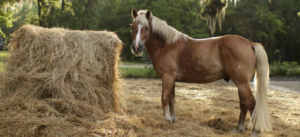 Use of Round Bales for Horses: The unpredictable weather and barren pastures of winter complicate forage-feeding for horse owners. Because of this, many rely on round bales to provide necessary forage.
Use of Round Bales for Horses: The unpredictable weather and barren pastures of winter complicate forage-feeding for horse owners. Because of this, many rely on round bales to provide necessary forage.Round Bale Advantages
“Using round bales as part of a feeding system has advantages. They are economical compared to traditional square bales. This is important as hay is commonly the most expensive component in the diets of mature horses,” said Kathleen Crandell, Ph.D., a nutritionist for Kentucky Equine Research. “In addition, round bales are convenient to use. This is especially true when forage must be transported through snowy and ice-covered paddocks in the dead of winter.”
However, round bales should be used appropriately to offset potential drawbacks. This includes loss of nutrients, mold growth, negative effects on the respiratory system, and waste.
“Freeze-thaw cycles may have an effect on certain nutrients, particularly organic nutrients like proteins and fat-soluble vitamins,” explained Crandell. “Other nutrients, like minerals, appear to be fairly stable even if the hay is frozen, just as long as the hay stays dry.”
Once the hay gets wet, forage quality degrades rapidly. Further, when wet hay freezes and thaws, even more damage can occur to the protein found in the hay, particularly if it is a slow thaw.
If hay gets soaked through, there will be some leaching of nutrients and nonstructural carbohydrates, just like when hay is soaked for horses with certain metabolic conditions. Fat-soluble vitamins decline as hay ages, but soaking may intensify losses.
Because of the structure of the round bale, rain does not penetrate into the inner layers. This is especially true if the bale has been tightly bound and laid on its side.
“Mold growth is another factor to consider when hay gets wet and does not dry. Mold not only affects nutrient loss but can also be toxic to the horse,” Crandell advised.
Consumption Advice
Because of the inevitable losses of nutrients, round bales exposed to the elements should be consumed in four to seven days. Depending a bit on the size of the bale (they can vary greatly in weight), four horses can usually consume a bale in this time frame. Be cognizant of each horse’s body condition score when feeding herds, and remember that if there are too many horses trying to eat from one bale there may be a problem with competition.
“When using round bales, feeding a concentrate may be necessary if the hay doesn’t provide sufficient calories for maintenance of body condition. For horses that can maintain weight with hay alone, use a research-formulated vitamin and mineral supplement or ration balancer,” advised Crandell.
Waste from large round bales can be reduced through the use of feeders. Various models are marketed to the horse industry, and dimensions of the feeders vary. Some have roofs to protect hay from precipitation. In one study that compared nine models of round-bale feeders, hay waste ranged from 5% to 33%, while waste when fed with no feeder was measured at 57%.*
*Martinson, K., J. Wilson, K. Cleary, W., Lazarus, W. Thomas, and M. Hathaway. 2012. Round-bale feeder design affects hay waste and economics during horse feeding. Journal of Animal Science 90:1047-1055.
Would you like more information about the Use of Round Bales for Horses? Contact us at J & J Hay Farms by clicking here!
Article brought to you by KER.
